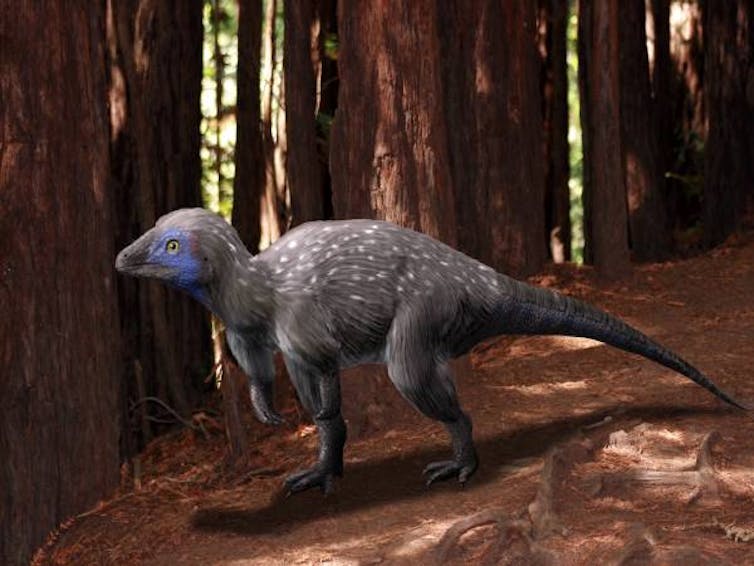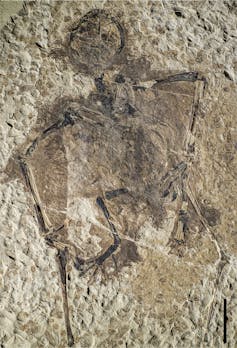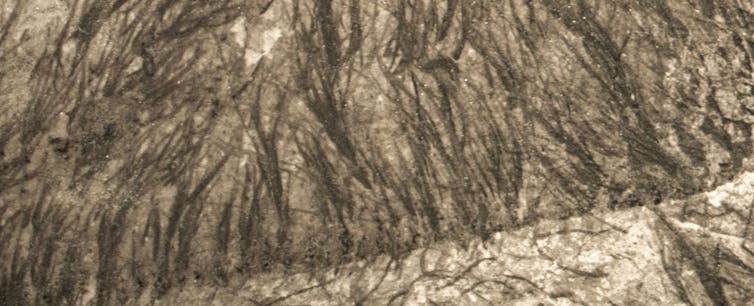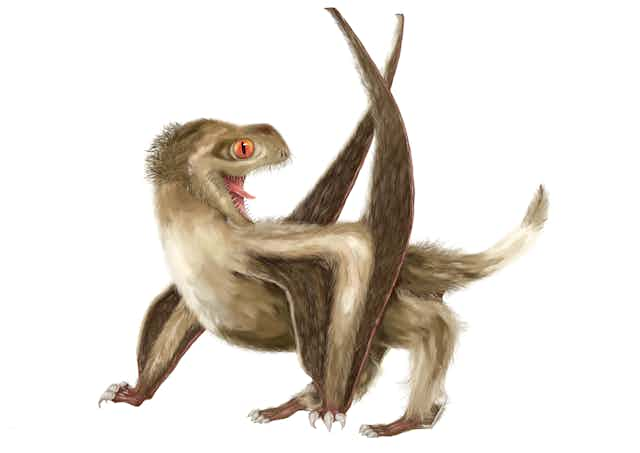When fossils of the oldest known bird, Archaeopteryx, were first discovered almost 160 years ago, the find created a puzzle that has troubled palaeontologists ever since.
These fossils were celebrated for their chimera-like combination of supposedly reptilian features (such as a bony tail and jaws with teeth) and those seemingly unique to birds – in particular, feathers. They helped demonstrate that birds actually evolved from dinosaurs.
But they also presented a major evolutionary problem. The prehistoric feathers were indistinguishable from those of birds today. So it wasn’t clear how or when feathers evolved, and in what kinds of ancient beasts.
Spectacular fossil discoveries from China in the mid-1990s upended our notions of feather evolution, as they revealed that feathers are not, in fact, unique to birds, but also occurred in many dinosaurs. Over the past 30 years, further fossil finds have revealed remarkable details of the evolution of feathers and flight.
Today, more recent discoveries of what appear to be feathered fossils of pterosaurs, the flying cousins of dinosaurs, have led to the theory that feathers first evolved even earlier with the ancestors of all these creatures. But not everyone is convinced, and the debate over the origins of feathers continues.
Feathered dinosaurs
Dinosaurs had many more types of feathers than we see in birds today. Some dinosaurs had four wings. Some species dispensed with wings altogether and glided using large flaps of skin). At least some dinosaurs had colourful feathers, used for camouflage and mating displays.
And as feathers evolved, so too did the skin of dinosaurs and birds – even starting to produce dandruff. But still, for many years, feathers were known only from maniraptoran dinosaurs (the group of species which actually includes birds).
There were hints that feather evolution wasn’t that simple. Feather-like structures, also termed “protofeathers”, were reported in ornithischian dinosaurs. Theoretical models predict that the first feathers would have resembled hair-like filaments. The simple hair-like shape of the fossil filaments, however, led some workers to doubt whether they really were feathers, rather than degraded remains of some other material, such as skin collagen.

In 2014, a Jurassic ornithischian dinosaur from Siberia known as Kulindadromeus was discovered that had both simple monofilaments and more complex feathers emerging from its skin. This dinosaur confirmed that feathers are not just a feature of maniraptoran dinosaurs, but probably originated before the major dinosaur groups diverged.
Clearly, the ability to grow feathers evolved with dinosaurs, although some dinosaur groups, especially the large sauropsids and the armoured ankylosaurs and stegosaurs, may have later lost this ability. But having skin outgrowths (hair), and later losing them is well known in mammals, including whales and elephants.

The question has become not whether feathers are unique to birds, but whether they are unique even to dinosaurs. Fuzzy hair-like fibres reminiscent of dinosaurian “protofeathers” have been known for some time in pterosaurs. The pterosaur filaments were traditionally termed “pycnofibres” and were considered distinct from feathers in form and evolution.
But in 2018 we discovered simple filaments and, remarkably, three types of branched feathers preserved in pterosaurs from the Yanliao Biota fossil deposits from the mid-Jurassic epoch, located in China. Although the branching structure is not quite the same as in birds today, the feathers are rich in keratin, the protein commonly found in feathers and hair, and contain colour-bearing melanosomes.
This discovery strongly suggests that the fuzzy pycnofibres of other pterosaurs are also primitive feathers. This likely means that the ability to grow feathers evolved once, around 100 million years before Archaeopteryx, and was passed down to various groups of species.
Not surprisingly, this notion of feathery pterosaurs has proven contentious and other researchers have challenged our ideas. The debate focuses on a few key issues, with questions regarding preservation of the feathers front and centre.

Leicester University’s Dave Unwin and Portsmouth University’s Dave Martill argue that the pterosaur structures may be too degraded for us to be certain that they are feathers, and that they could actually be degraded skin fibres. But the characteristics of the feathers aren’t consistent with degradation and unravelling of composite fibres. They are also sinuous and lack the spatial organisation of skin fibres and contain melanosomes, which are not incorporated into skin collagen.
Unwin and Martill also point out that the keratin and other chemical evidence we found could be contamination. But this seems unlikely because it was only found in the feathers and not in the surrounding tissue.
Another issue is that other pterosaur fossils only have simple hair-like filaments and not branched structures. But birds today have many different feather types, so these filaments could be a different or early, simple form of feather – an idea supported by the theoretical models.
Ongoing debate
It is always a good idea to question interpretations of new fossils, especially where the evolutionary implications are far-reaching, although we believe the evidence for pterosaur feathers is there in the fossils. Clearly, however, there is more to be done, and we are currently conducting more tests on the fossils in order to better understand the chemical composition and structure of the feathers.
Ultimately, if we are correct, it seems that the first feathers will be found in the ancestors of pterosaurs and dinosaurs in the Early Triassic epoch, roughly 252 million to 247 million years ago. Unfortunately, we don’t have any fossils showing soft tissue preservation from this time period.
But if we’ve learned anything from the fossil record of feathers, it’s to expect that more will be discovered. Over the years we’ve had to repeatedly broaden our search for fossils with feathers, and for what ancient feathers looked like. Who knows what insights future fossils will bring.

